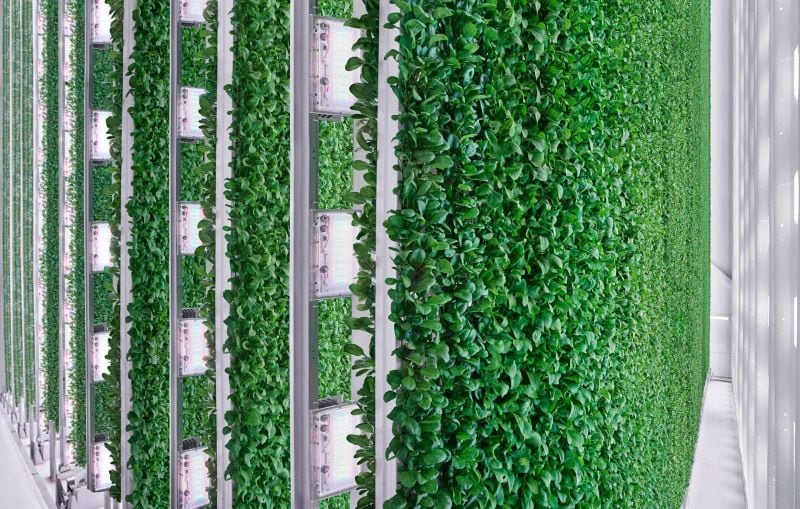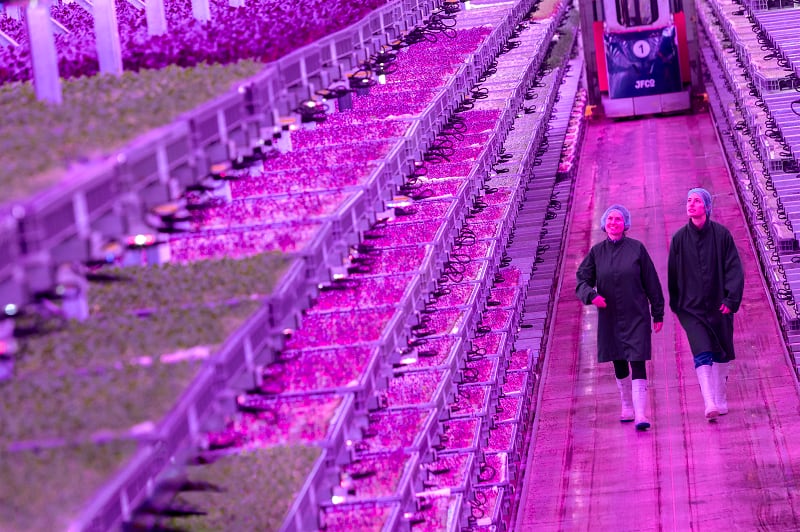The indoor farming segment has seen funding decline by a factor of five from its peak in 2021, according to PitchBook’s Q1 agtech report.
The market for controlled environment agriculture (CEA), including both high-tech greenhouses (HTGH) and vertical farms (VF) has been through a significant downturn over the last several years, notes Stephan Dolezalek, managing partner at investor Grosvenor Food & AgTech.
He should know. Grosvenor is an investor in AeroFarms, whose capital-intensive vertical farming model could not achieve profitability fast enough, leading to a liquidity crunch that forced it into restructuring. It emerged from bankruptcy proceedings in September last year with a new CEO, Molly Montgomery.
Other large indoor farming companies to have recently filed for bankruptcy include AppHarvest, and Infarm.
Much of the downturn was down to overblown expectations, says Dolezalek. “Doing indoor farming well is about a lot more than building a high-tech building with HVAC and automation and a number of companies spent large sums to build indoor farms that then couldn’t produce a profit.
“I think people got really excited without really understanding the complexities of where it was going to work; how it was going to work, and where it was most beneficial. As we are learning that think in the next two years, we’ll be able to start saying this is what a successful vertical farm actually looks like.”
There is still, however, not enough good information to guide investors and markets on what success can and should look like, he believes. But he still backs the fundamental premise of the indoor farming segment; for instance, its potential to address many challenges of traditional agriculture, such as water scarcity, land constraints, climate change impacts, and food safety concerns, while providing economic and social benefits to urban communities.
“Climate change and volatility is making life for field farmers more difficult and already thin margins less certain,” he said. “So there is a sense of inevitability around CEA that has investors coming back and making new investments.”
That being said, he’s not sure that those investors are well informed. “I get, on average, one new pitch deck per week on a CEA business, most of them alleging they are ‘the best,’ ‘the biggest,’ ‘the most sustainable,’ ‘the most scalable,’ etc. Importantly, none of them say ‘we are profitable…’ instead they say ‘we will, in due time, be profitable’. That, to me, remains the biggest challenge when you are trying to move a capital-intensive industry toward a new business model. Investors need to see what success looks like. That has been true for wind farms, solar manufacturers, electric car companies, battery companies and now needs to be so for CEA as well.”
What barriers are still besetting this market?
While indoor and vertical farming offer many benefits, overcoming these economic, environmental, technological and operational challenges is crucial for widespread adoption and long-term sustainability of these farming method, the investor told us.
“We have always had romantic notions about small farms, and we seem to have the same about ‘container-sized’ or modular CEA facilities,” he said. “But there are some realities that dictate scale – you need automated harvesting and packaging and those lines are expensive and require a big scale to be cost-justifiable.”
Logistics is another area often overlooked by investors with a rose-tinted view of the sector. “You also need to deal with shipping logistics; sending half full trucks to local markets is not a viable business model,” explained Dolezalek. “But building a farm of sufficient scale is not a $10-30m investment; it is typically a $75-150m investment, all-in, including ramp-up costs.”
Not many investors want to sink that much money into an unproven business model, he says. But once you have a HTGH or VF that has proven profitability, making more of same is much more investible. In addition, “once you have a few of those proven business models, then small investors and companies can begin building improvements to those facilities, which can be done with much less capital and continue to bring costs down”.
Another reality many investors seem to ignore, according to Dolezalek, is that it is very difficult to build new companies in markets with big incumbents by trying to compete on a commodity basis.
“Trying to grow head lettuce in competition with field farms is not likely to be a good starting point,” he explained. “They already do that extremely well. It’s much smarter to go after a market niche that you can have to yourself, particularly if it is also a premium priced segment. Then, as you scale, you can bring costs down and start competing in the commodity markets.
“These are lessons we learned in the transition from CRTs to flat screen televisions, in personal computing, in mobile phones, in electric cars – so you would think they are well understood, but each generation of investors seems determined to relearn those lessons for themselves.”
To stress the future importance of automation in the indoor farming sector, Dolezalek thinks the winners will be farms that “basically aren’t touched by human hands”.
One huge barrier, for instance, that Dolezalek’s sees far too many companies ignore, is that these are sensitive biological systems. They are a lot more than roboticized, automated, high-tech greenhouses – and, as such, they require a very high level of growing, biological, and systems skills that many of the players in the CEA sector have failed to properly take into account. “Success requires a very careful blending of the best of the new: high-tech, with the best of the old: operating experience.
“Lastly, once you have proven models, you will also begin to see infrastructure lenders come into the segment – that will then make it easier for equity – venture capital and private equity – to provide the rest of the capital needed to scale. We are just now starting to see that happen.”
What does a successful vertical farming company look like?
One company defying the trend of falling investment in the indoor farming sector is Oishii, whose $134m Series B fundraise in February was the largest deal in the first quarter of 2024. It is very much an example of a company offering a high-quality product – strawberries – at affluent consumers prepared to pay a premium for an elevated food experience. This way it can cover the higher operating costs for vertical farmers.
“They are incredibly expensive strawberries,” said Dolezalek. “But i think they’ve done the right approach by saying ‘we need to focus on those strawberries because they will cover our costs. They are so much more tasty so we can in fact charge a price for them that will cover the initially higher costs of our farms’. That’s a logic we very much subscribe to.”
Case in point, AeroFarms, similarly, is producing microgreens. They boast five times the nutrient density of a normal leafy green. “They might cost twice as much as a leafy green that you’re buying from another vertical or indoor farm, or three to four times field grown,” Dolezalek observed. “But if you’ve got five times the nutrient density then you’re getting more nutrients per dollar.”
Consumers are prepared to pay for such a product, he believes. “Because CEA and particularly VF plants can be grown without human contact, in enclosed tightly monitored spaces, with little to no pesticides or insect/bacterial infestations, they often don’t need to be washed, are less prone to safety recalls, can have longer shelf life and provide the consumer with a highly consistent product; they are what consumers are increasingly choosing to buy.
“I believe that once we show that we can produce these plants reliably, profitably and in forms consumers love, we will increasingly see new varieties come to market that take advantage of the degree of control and fine-tuning possible in CEA facilities.”
Could indoor farms become medicine factories?
It is for this reason Dolezalek sees scope in the longer term for the indoor farming market to disrupt the supplements sector, possible even more than food. Innovators will increasingly optimise crops for certain nutrients, for example, and use indoor farms to grow crops rich in peptides and amino acids.
“It’s been shown that by changing light, temperature and stress levels, you can increase specific vitamins and minerals. If you start adding CRISPR technologies, you can again get to very focussed outputs.”
And given the significant health needs of an ageing world, it is not such a stretch to predict indoor farms might be eventually viewed, therefore, not as a sector that can play a complementary role in the future of food production but as “growing facilities for much more specific nutrient needs as opposed to commodity foods”.




